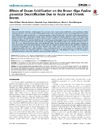Identificador persistente para citar o vincular este elemento:
https://accedacris.ulpgc.es/jspui/handle/10553/47958
| Título: | Effects of ocean acidification on the brown alga "Padina pavonica": decalcification due to acute and chronic events | Autores/as: | Gil-Díaz, Teba Haroun, Ricardo Tuya, Fernando Viera-Rodríguez, María A. Betancor Curbelo, Séfora |
Clasificación UNESCO: | 241705 Biología marina | Fecha de publicación: | 2014 | Proyectos: | Respuesta de la Bota Intermareal A Perturbaciones Humanas: Efecto de la Eutrofización en El Marco Del Actual Contexto Climático. Status Ecologico y Vulnerabilidad de Ecosistemas Marinos Canarios Al Cambio Climatico: Indicadores Funcionales y Respuesta Adaptativa Al Stress. |
Publicación seriada: | PLoS ONE | Resumen: | Since the industrial revolution, anthropogenic CO2 emissions have caused ocean acidification, which particularly affects calcified organisms. Given the fan-like calcified fronds of the brown alga Padina pavonica, we evaluated the acute (shortterm) effects of a sudden pH drop due to a submarine volcanic eruption (October 2011-early March 2012) affecting offshore waters around El Hierro Island (Canary Islands, Spain). We further studied the chronic (long-term) effects of the continuous decrease in pH in the last decades around the Canarian waters. In both the observational and retrospective studies (using herbarium collections of P. pavonica thalli from the overall Canarian Archipelago), the percent of surface calcium carbonate coverage of P. pavonica thalli were contrasted with oceanographic data collected either in situ (volcanic eruption event) or from the ESTOC marine observatory data series (herbarium study). Results showed that this calcified alga is sensitive to acute and chronic environmental pH changes. In both cases, pH changes predicted surface thallus calcification, including a progressive decalcification over the last three decades. This result concurs with previous studies where calcareous organisms decalcify under more acidic conditions. Hence, Padina pavonica can be implemented as a bio-indicator of ocean acidification (at short and long time scales) for monitoring purposes over wide geographic ranges, as this macroalga is affected and thrives (unlike strict calcifiers) under more acidic conditions | URI: | https://accedacris.ulpgc.es/handle/10553/47958 | ISSN: | 1932-6203 | DOI: | 10.1371/journal.pone.0108630 | Fuente: | PLoS ONE [ISSN 1932-6203], v. 9 (9), art. e108630, (Septiembre 2014) | Derechos: | by-nc-nd |
| Colección: | Artículos |
Citas SCOPUSTM
15
actualizado el 08-jun-2025
Citas de WEB OF SCIENCETM
Citations
13
actualizado el 12-ene-2026
Visitas
71
actualizado el 03-ago-2024
Descargas
59
actualizado el 03-ago-2024
Google ScholarTM
Verifica
Altmetric
Comparte
Exporta metadatos
Los elementos en ULPGC accedaCRIS están protegidos por derechos de autor con todos los derechos reservados, a menos que se indique lo contrario.
